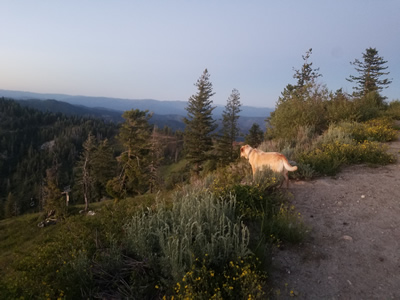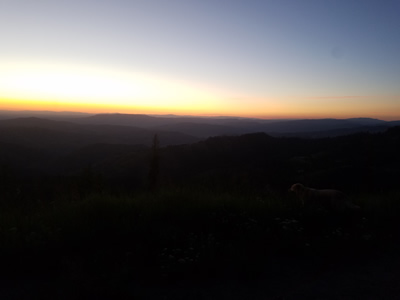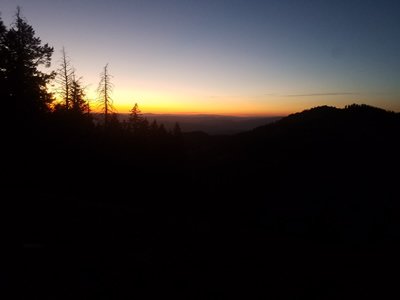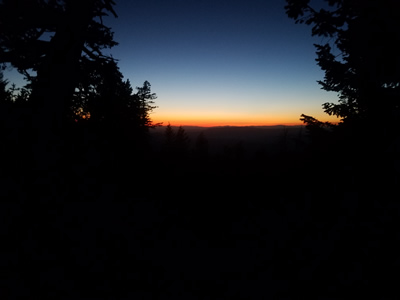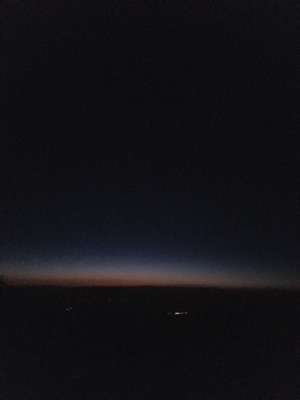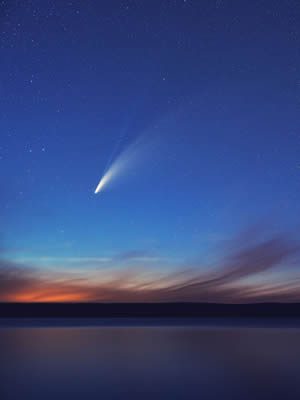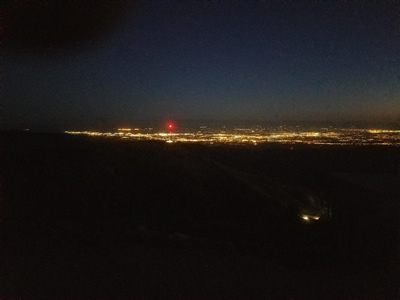Comet Neowise
Until recently, the only comet I had ever seen was Comet Hale-Bopp, which was visible in 1996-97. If you were only going to see one comet that was definitely one to see. It was unusually bright and was visible with the naked eye for eighteen months. That's a long time - most comets are only visible for a dew weeks. I remember seeing it many times but one stands out in particular. It was early morning before dawn and I was driving to the airport to catch an early flight to the Bay Area for a work trip. Even from my car the comet was a spectacular sight, high over Lucky Peak on the northeast horizon.
A few weeks ago I read about another comet that was predicted to be visible to the naked eye and viewable from the northern hemisphere. It had a strange name - Comet Neowise. Comets are named after the person who discovers them. For example, Comet Hale-Bopp was discovered by two amateur astronomers, Alan Hale (no, not the skipper from Gilligan's Island) and Thomas Bopp. This is a big incentive to amateur astronomers to be comet hunters and most new comets are discovered by amateurs. But Comet Neowise was first observed by the WISE (Wide-field Infrared Survey Explorer) space telescope as part of the NEO (Near Earth Object) search program run by NASA. So it ended up with an unusual name - Comet Neowise.
From what I read, the comet was bright enough to see with the naked eye. But it was also was low on the horizon, visible for just a short time before sunrise (early July) or after sunset (mid-late July). It would be closest to earth in August but astronomers were predicting that it would be very faint by then. It would only be bright enough to see while it was still close to the sun - and that meant it would be low in the sky when it was really dark.
There is a lot of skyglow in the Treasure Valley, and especially in our neighborhood. I figured that if I was going to have any chance to see it I would have to go somewhere outside of town. Even then it wasn't a sure thing. Through the first week of July I was never quite motivated enough to head out at 3 am so that I could be in position to see the comet just before sunrise.
By mid-July when the comet was visible after sunset I began to get serious about trying to get a good look at it. My plan was to drive up to Bogus Basin, park at the Upper Lodge and hike to the top of Shafer Butte. It seemed like it would be a perfect viewpoint. It's the highest mountain for at least twenty miles in any direction so nothing would block my view, even if the comet was close to the horizon. And since I would be looking to the northeast, the bulk of the mountain would block the skyglow from the Boise area.
I've been up Shafer Butte so many times that I've said that I could do it with my eyes closed. Well, this would be my chance.
Actually I had already done it once before. On a really hot day three years ago, Abby and I waited till late in the evening to hike to the top. It was fully dark by the time we came down and we had no problems. In fact it was very pleasant.
According to the almanac, sunset would be at 9:25. I figured it would take about forty five minutes to reach the summit so I wanted to start fifteen or twenty minutes before sundown. That way I would be on top in plenty of time and could just wait for it to get dark enough to see the comet. That is if I could see it at all.
On the drive up to Bogus I was surprised at how many people were along the road. Most of the trailhead pullouts that access bike trails in the foothills still had lots of cars. There were quite a few cars on the road too. It was a little surprising for late on a Wednesday evening. I guess people take off after work and drive up the hill with their mountain bikes to get some time riding on the trails in the foothills.
I parked at the upper lodge and Abby and I started hiking at 9 pm. Perfect. Everything was just according to plan...at least for a while.
The light was starting to fade but there was enough to follow the service road as it climbed up the west side of the mountain. As we came around the corner onto the north side we passed the spot where the Face Trail split off. There was a new sign there with some kind of warning. I had to strain to try to make out what it said in the low light with my sun glasses on. Wait! What? I couldn't see the sign clearly because I had my sunglasses on? How was I going to see a barely visible to the naked eye comet wearing sunglasses? My eyesight is poor so no glasses was not an option.
I stopped and frantically went through my pockets. I didn't have the case with my regular glasses. I took off my pack and went through every pocket...twice. Nada. I'd spent fifteen minutes climbing already but I had to turn around. Ten minutes later I was back at the car. Sure enough, my regular glasses were sitting in the console. Ok, hike up the mountain, take two. At 9:25 Abby and I started up again, exactly as the sun was dropping below the horizon. The almanac had been spot on for the time of sunset.
Actually this timing worked out better. There was still plenty of light for most of the way up and we reached the top before it was completely dark. Although it had been hot in the valley during the day, it was cool on the mountain now - maybe mid-fifties. Near the top a chilly breeze picked up from the south. As soon as I reached the top I got my wind parka out of my pack and put it on. I was actually on the cool side of comfortable, so I found a spot to sit down at the base of the lookout tower where I was out of the wind and had a clear view to the north. There was still a slight glow in the sky to the west so I spent the next fifteen minutes checking websites to make sure I knew exactly where to look for the comet.
According to the star maps that I looked at, the comet would be right below Dubhe, one of the main stars in the constellation Ursa Major. I can't identify all of the stars in the Great Bear, but can always spot the subset which form the Big Dipper. Dubhe is at the very tip, or spout, so it was an easy to find reference point. I had a pair of lightweight binoculars with me and used it to scan the sky below the Big Dipper. They aren't great but are better than the naked eye. About 10:30 it was finally dark enough and I found the comet with my binoculars. There it was. I was pretty excited when I first spotted it.
I stayed on top of the mountain for another half hour. By then there wasn't even a hint of light left in the west. The comet was clearly visible with the naked eye. The tail was beautiful, much larger than I expected it to be. It wasn't very bright though. I could actually see it better by looking slightly to the side so I was looking at it with a more light sensitive part of my eye. Still, it was an amazing sight and the trip up the mountain to get a really good view of it was well worth it. Besides the comet, the whole sky was very dark and full of stars, many more than I would see in the city. Even the Milky Way was clearly visible, stretching overhead.
Abby didn't seem to enjoy being up on the mountain at night. She stayed very close, sitting right up against me. When I finally decided to head down before I started to get cold, Abby seemed glad to get going.
As soon as we dropped a hundred feet or so down the north side of the mountain we were out of the wind. After that the rest of the way was quite pleasant hiking, with spectacular views all the way. I had a headlamp with me but only used it in a few spots, maybe ten percent of the time. Mostly I hiked with the headlamp off to preserve my night vision. Even in the dark it wasn't hard to follow the service road. All the way down and around the north side of the mountain, the comet was right in front of me, the Milky Way was behind me and stars were everywhere. When we finally turned onto the west side of the mountain all the lights of the Treasure Valley came into view, stretching from Boise far to the west to Nampa and Caldwell.
The only annoying thing was that when we got close to the lodge there were two extremely bright lights in the parking lot. In fact, my car was parked right next to them. They were unpleasantly bright and ruined my night vision so I couldn't enjoy the view of the sky anymore. Oh well. It was only for the last ten minutes or so.
About five minutes before we reached the lodge Abby started growling and then barking ferociously at something right ahead of us. Oh, oh. Grizzly bear? Bigfoot? I switched on my headlamp so I could see why she was so upset. There were two people cowering on the side of the track, looking like they thought Abby was going to eat them. I called Abby off and apologized for her behavior. They didn't seem to mind so we chatted for a few minutes. It was a teenage couple walking around the mountain to see the comet. They were the only people I saw that night. I had expected more people to be out to get a look at the comet but Abby and I had the mountain all to ourselves except for two minutes.
We were back to the car by 11:30. Although no one had been hiking up high, on the drive down I saw quite a few cars in pullouts along the road and (mostly young) people hanging around doing - something.
I had my phone with me and took pictures but the comet was too faint to show up in any of them. I did get some really spectacular photos of the sunset while we were climbing up the mountain as the sky in the west progressed from yellow to orange to red to deep red to purple. It was a beautiful hike even before I saw the comet.
The next day I told Sandy about our hike and she was very interested in the comet. Not quite interested enough to go up Shafer Butte at night but we did go for a walk two nights later. We took Abby and walked to the park near our house where there weren't quite as many street lights as there were in front of our house. We also had a clear view to the part of the sky where the comet was. It wasn't as spectacular as from up on the mountain but since I knew where to look we could see it faintly. With binoculars we could see it clearly. So Sandy got a good chance to see the comet as well. Lucky for us as the comet won't return for almost seven thousand years. It's quite possible that there won't be another comet visible to the naked eye in our lifetimes.
